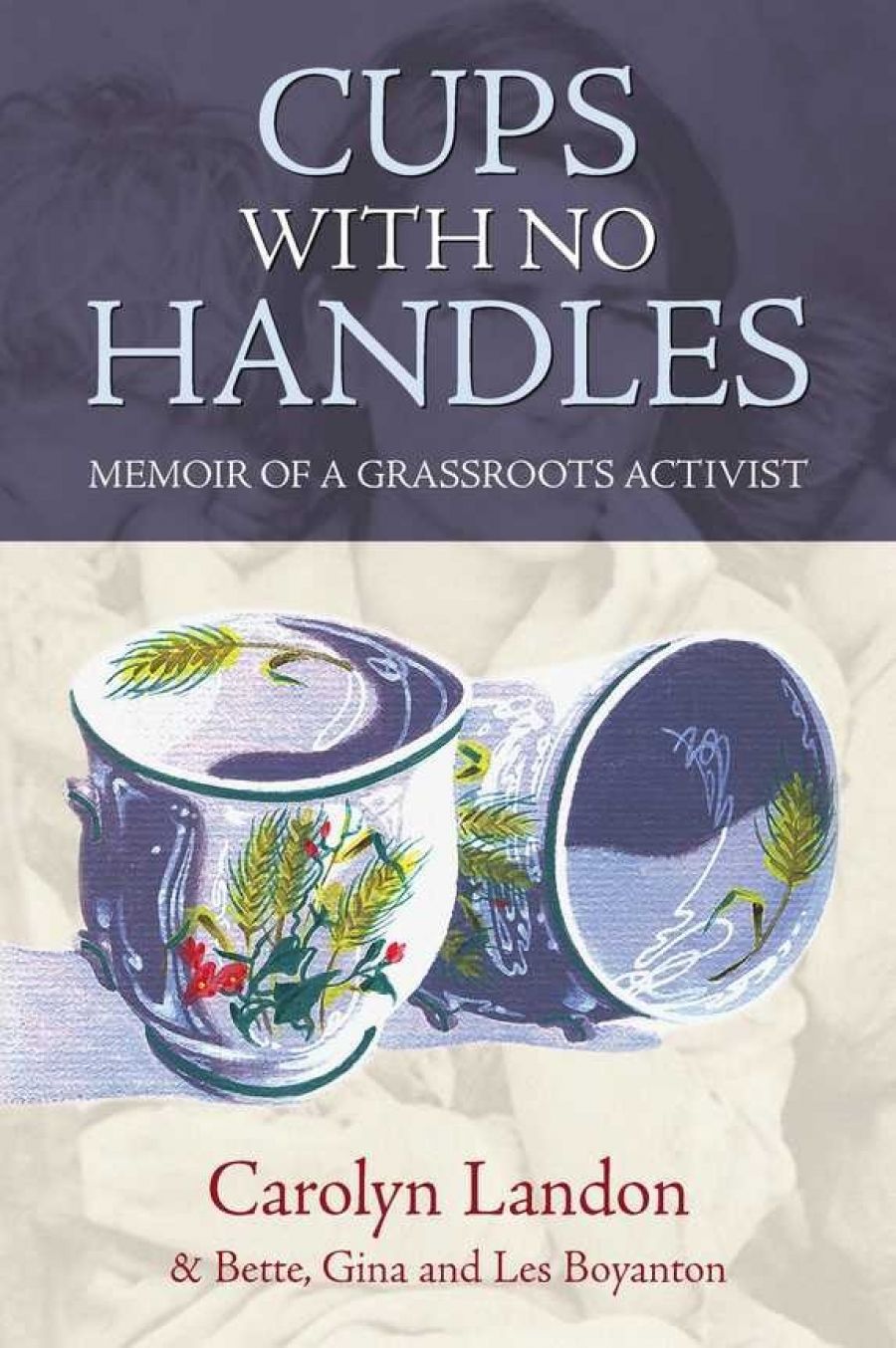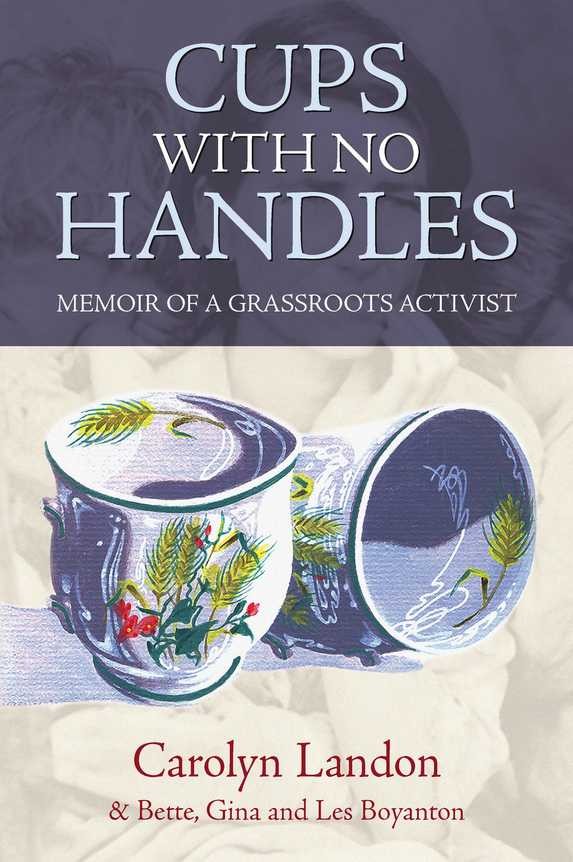
- Free Article: No
- Custom Article Title: What choice?
- Review Article: Yes
- Article Title: What choice?
- Online Only: No
- Custom Highlight Text:
The word ‘memoir’ is used with a nice precision in the title of this beautifully written book. The Macquarie Dictionary distinguishes between the singular and the plural meanings of the word: ‘memoirs’ are autobiographical, ‘records of one’s own life and experiences’; a ‘memoir’ is a biography. Almost all of the book is written in the voice of its protagonist, Bette Boyanton, with some sharp interventions from her daughter Gina; her husband Les is credited as a co-author, though he does not speak. But the book also stands firmly as a biography, elegantly crafted by its major author, Carolyn Landon.
- Book 1 Title: Cups With No Handles
- Book 1 Subtitle: Memoir of a Grassroots Activist
- Book 1 Biblio: Hybrid Publishers, $29.95 pb, 300 pp
- Book 1 Cover Small (400 x 600):

- Book 1 Cover (800 x 1200):

Landon is an experienced co-author, skilled at bringing oral accounts to the written page. Her first book, Jackson’s Track: Memoirs of a Dreamtime Place (1999), set down the memories of Daryl Tonkin, a Gippsland pioneer who married an Aboriginal woman. Her second, Jackson’s Track Revisited (2006), brought more voices to the story, especially Aboriginal voices. Landon critiqued both Tonkin’s memories and her own understandings of the various accounts, as interviewer, researcher and historian. These insights enrich her story of Bette Boyanton, communist and reluctant feminist.
In the preface, Landon uses her own voice to introduce Boyanton to the reader. She describes their first meeting in 1977, at the Commercial Hotel in Warragul. Boyanton had invited Landon and her fellow teachers from the high school to the pub because she wanted their help in organising an anti-uranium mining protest march. The young teacher met a woman ‘who looked like somebody’s mother, like my mother or even my grandmother’, ‘small and plump with greying hair’ and wearing ‘elastic-topped slacks with a twin-set and a bright scarf’ – ‘not like one of those enlightened older women who had lived bohemian lives, wore lots of beads and dangly earrings and understood feminism. She just didn’t fit the image of someone who spoke the way she was speaking to us.’ But the old activist knew exactly what she was doing; the protest made it on to the Channel Nine news. Landon’s narrative device works here both to establish the personal and political relationship between author and subject, and to introduce the working-class style and practice of communist activists to present-day readers.
Boyanton’s life is presented as being crucially influenced by her involvement with the Communist Party of Australia, but that story does not shape the book. Landon has Boyanton begin her account in 1978 with her adoption of a more current cause. The first words set up the central themes of recollection and of political engagement:
Perhaps because today is an August day similar to another day long ago, I am caught up remembering how my imagination was taken over by an idea. It was an idea that seemed attuned to everything I believed in and had worked for my entire life.
The idea was the movement for Women’s Learning Centres. It came to Boyanton at a moment of great personal weakness, when she was laid low by chronic asthma. Boyanton’s account explains that it was also a time of isolation from her children, isolation which the reader comes to realise was caused at least partly by the intensity of her political commitment.
This life story can be read as vivid social history, as an account of the impact on family life of the harsh poverty of the 1920s and 1930s, and as an honouring of the brave activism growing out of that poverty. But for this reader the most powerful themes are personal ones, turning on the tensions between and within social action and family relationships. Boyanton tells her story with fierce honesty and slowly dawning self-understanding, often pushed along by her equally honest daughter.
Bette’s communist father is the natural hero of her story, setting the guidelines for her life of passion and commitment. It is Gina who insists that Bette’s mother should have a place in the story, overcoming Bette’s reluctance to speak of her. Her relationship with her mother was difficult: ‘I always felt a natural sympathy for Mum, but it’s just that she made me so angry when she wouldn’t stand up for herself. She never demanded to be treated fairly. She didn’t even recognise that she had rights.’ And while her father was ‘my life and my light, my salvation’, her mother was a horrible warning of an inevitable future:
This is what always frightened me more than anything ... I was aware that, sure as eggs, I was going to grow up to be a woman one day, and when that happened, with my mother as a role model, I had to ask myself how was I ever going to escape a life of drudgery and servitude? What choice did I have?
The passages of Bette’s life – from school drop-out and factory worker, to shop girl and assistant nurse, to war bride and young mother and very reluctant farm wife – all of these are charged by that question: ‘What choice did I have?’ Becoming a wife and mother (and inevitably a household drudge) are happenings rather than choices, and the choices she makes – to maintain her commitment to communism and a better society – fall heavily on husband and children.
The narrative follows these passages, finally cycling back to the story of how Bette and her neighbours founded a Women’s Learning Centre in Warragul. In Landon’s hands, this story – told independently by both Bette and Gina – becomes a tentative resolution of the issues that have divided mothers and daughters in this biography, and across the twentieth century. It is a moving achievement.


Comments powered by CComment